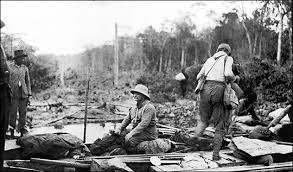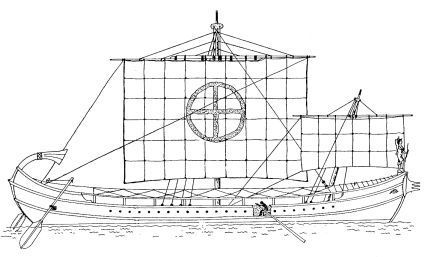Richard Conniff's Blog, page 81
January 9, 2013
Smaller Fleas to Bite ‘Em
 I’ve been spending a lot of time lately talking with people about the microbiome, that cloud of bacteria, fungi, and viruses that live on all of us and (most of the time) help keep us healthy. Much of science these days (see my post Life Inside Life Inside a Leaf) seems like a variation on the Jonathan Swift verse, from “On Poetry: A Rhapsody.” Swift was writing about critics, and only invoking natural history by analogy. But he got it right:
I’ve been spending a lot of time lately talking with people about the microbiome, that cloud of bacteria, fungi, and viruses that live on all of us and (most of the time) help keep us healthy. Much of science these days (see my post Life Inside Life Inside a Leaf) seems like a variation on the Jonathan Swift verse, from “On Poetry: A Rhapsody.” Swift was writing about critics, and only invoking natural history by analogy. But he got it right:
So nat’ralists observe, a flea
Hath smaller fleas that on him prey;
And these have smaller fleas to bite ‘em.
And so proceeds Ad infinitum.


January 8, 2013
The Lure of Long Distances: Songs for Spacemen
[image error]
The space shuttle astronauts journeyed up to 4.3 million miles on a single flight. But like all adventurous travelers, they also pined for small reminders of life back home. Name the artist whose music was at the top of the charts for space shuttle wake-up calls:
a. Elton John, whose hits include “Rocket Man”
b. Aaron Copeland, composer of “Fanfare for the Common Man”
c. Paul McCartney, whose songbook includes “Off the Ground” and “Soggy Noodle.”
d. Dean Martin, who sang “Volare”
And the answer is:
(c) Paul McCartney–with the Beatles, Wings, or solo–has awakened 12 Shuttle crews, and gave a live performance of “Good Day Sunshine” in 2005. Also popular with Shuttle crews: The Beach Boys (“I Get Around”), U2 (“Vertigo” and “Beautiful Day”), and Louis Armstrong (“What a Wonderful World”). Dean Martin was a hit on the final day of many flights when he sang “Goin’ Back to Houston.”


January 7, 2013
Taxonomy for Dummies
It’s embarrassing to admit, since my books are about the natural world, but I often make the same dumb mistakes of confusing dolphins with porpoises, or butterflies with moths. So here’s some help from Bird and Moon.
Now what about crows and ravens?



Murdered at 14 for Fighting to End Polio
I’ve been looking for a photograph of Farzana Bibi, a 14-year-old girl shot and killed last month by Islamic extremists in Pakistan because she was working on a polio eradication team.
And here she is.
Farzana joins a long line of medical martyrs who have died to free us from epidemic diseases. But few have died so needlessly, or with victory so near: Polio, which once crippled and killed millions, was on target to be eradicated from the Earth sometime later this year.
As a reminder, here are a couple of news account describing the killings, and also suggesting why eradication probably won’t happen soon:
A volunteer who was shot during a wave of attacks on polio-vaccination teams has succumbed to his injuries in Pakistan. That brings to nine the number of health workers killed since December 17.
Officials say the student volunteer died on December 20, a day after he was shot while helping distribute polio drops in the northwestern city of Peshawar.
Five of the nine health workers killed were women.
The bloodshed prompted United Nations agencies to suspend their campaign against polio in Pakistan after the attacks.
The Islamic terrorist group Jundullah claimed responsibility, telling RFE/RL’s Radio Mashaal that polio vaccination is forbidden in Islam.
Pakistan is one of only three countries where the disease is endemic.
I only have partial information on the victims, but here are the sad additions to the list of Medical Martyrs I started a few weeks ago. Corrections or additional information are welcome:
Akhtar, Naseema (1977-2012), killed by terrorists in Karachi, Pakistan, for working with the World Health Organization to save her country from polio, age 35.
Bibi, Farzana (1992-2012), killed by terrorists in Peshawar, Pakistan, for working with the World Health Organization to save her country from polio, age 14
Last Name Unknown, Fahmida (1992-2012), killed by terrorists in Karachi, Pakistan, for working with the World Health Organization to save her country from polio, age 20
Last Name Unknown, Kaniz Fatima (1992-2012), killed by terrorists in Karachi, Pakistan, for working with the World Health Organization to save her country from polio, age 20
Last Name Unknown, Madiha (1993-2012), killed by terrorists in Karachi, Pakistan, for working with the World Health Organization to save her country from polio, age 19.
Mehsud, Umer Farooq, (1982-2012), killed by terrorists in Karachi, Pakistan, in Peshawar, Pakistan, for working with the World Health Organization to save her country from polio, age 30.


The Lure of Long Distances: Ancient Explorers
In about 325 B.C. the Greek explorer Pytheas dared to sail past Gibraltar out into the great world beyond, and may have gotten as far as Iceland. What important discovery did he make in his travels?
a. That the earth is round.
b. That the Celts were ferocious warriors who nailed their enemies’ heads over their doors.
c. That northern regions were inhabited by “a monstrous white bear.”
d. That the tides are associated with the phases of the moon.
And the answer is:
(d) Pytheas connected the tides with the phases of the moon. The extreme tidal changes in northern waters probably made the moon’s influence more apparent, especially after the minimal tides of the Mediterranean. In his book On the Ocean, Pytheas also introduced the idea of Thule, a distant northern land. It soon entered the human imagination, with the help of the Roman poet Virgil, as Ultima Thule, a mysterious place beyond the borders of the known world.
WEB EXTRAS: map of his journey: http://www.ub.uit.no/northernlights/eng/pyth02.htm


January 6, 2013
Outgunned in the War on Elephants
There’s a devastating report in today’s New York Times on the mismatch between military-trained and armed poachers, and the park rangers who stand between them and Africa’s last remaining elephants. Jeffrey Gettleman reports:
Just before dawn, the rangers were hunched over in prayer, facing east. They pressed their foreheads into the dry earth and softly whispered Koranic verses, their lips barely moving. A cool wind bit at their faces.

Djimet Seid
All of a sudden, Djimet Seid, the cook, said he heard “one war whoop — or maybe it was a scream.”
And then: “K-k-k-k-k-k-k,” the angry bark of a Kalashnikov assault rifle, opening up on fully automatic.
In an instant, an entire Chadian squad of rangers was cut down with alarming precision by elephant poachers who were skilled at killing more than just animals. Crouching in the bush, the poachers fired from a triangle of different spots, concealed and deadly accurate.
“If you go look at the infantry books, it’s exactly how you do a first light attack, exactly,” said Rian Labuschagne, a former paratrooper and now the manager of Zakouma National Park in southern Chad. “Our guys didn’t have a chance.”
Out here, among the spent bullet shells and the freshly dug graves, the cost of protecting wildlife is painfully clear. As ivory poaching becomes more militarized, with rebel groups and even government armies slaughtering thousands of elephants across Africa to cash in on record-high ivory prices, a horrible mismatch is shaping up. Wildlife rangers — who tend to be older, maybe a bit slower and incredibly knowledgeable about their environment and the ways of animals, but less so about infantry tactics — are wading into the bush to confront hardened soldiers.
The tactics employed by these new poachers are particularly alarming:
In Zimbabwe, poachers are spreading deadly poisons on elephant carcasses to kill vultures. By taking out the birds that serve as a natural early warning system that a kill has been made, the poachers make it even more dangerous for rangers because they have no idea when the poachers are around. In Mozambique, the authorities said that poachers have recently begun using land mines.
Kenya, which is considered tame compared with some of these other places, has lost six rangers this year, more than in recent memory. One of them was Florence Hadia Abae, pregnant and the mother of a small boy. In March, she was following the footprints of suspected poachers near Tsavo National Park, a fabled tourist destination, when a poacher popped out of the bush and shot her in the face.
One of her colleagues was killed in the same ambush, shot in the leg, then finished off with a short, brutish stroke of an ax.
“They had no idea what they were walking into,” said Rob Dodson, a British conservationist working near Tsavo.
What all this portends is the end of wild elephants in Africa:
Zakouma’s rangers are trying to make a last stand. The park’s once-great herd of elephants has been nearly exterminated. Ninety percent of it has been poached off in the past 10 years, one of the most drastic declines of an elephant population anywhere in Africa.
In 2002, there were 4,350 elephants; now maybe 450. Chad has endured several rebellions in recent years, sucking away resources from wildlife and creating instability along the Sudanese border, which allowed hordes of poachers to pour across. There has been only one confirmed birth of an elephant calf in the past two years.
“With all the shooting and stress,” Mr. Labuschagne said, “they don’t breed.”


The Lure of Long Distances: Teddy’s Evil Adversary

In 1913, after a failed bid for a third term as president, Teddy Roosevelt undertook a punishing expedition in Brazil, down the unmapped River of Doubt and on to the Amazon. Name the “evil” and ferocious adversary he encountered on route:
a. Piranhas capable of stripping a person to the bone.
b. An electric eel, which killed one of his boatmen on a river crossing.
c. A political consultant sent out to savage his reputation.
d. A 20-foot-long black caiman weighing 3000 pounds.
And the answer is:

(a) On the second day of his trip, when he had hardly gotten his feet wet, Roosevelt sent a letter to the newspapers back home. “Piranhas,” he wrote, “are the most ferocious fish in the world…They will snap a finger off a hand incautiously trailed in the water…They will rend and devour any wounded man or beast.” In fact, piranhas generally do not bother people and should have been the least of his worries. On the expedition, he would encounter dangerous rapids, hostile Indians, and deadly disease—but lived to recount his adventures in Through the Brazilian Wilderness. The River of Doubt is now called the Rio Roosevelt in his honor.

January 4, 2013
Why Cities Will Never Feed Themselves

Rooftop garden, Chicago city hall.
Back in 2010, a writer in Forbes magazine made this highly optimistic (not to say delusional) prediction:
By 2018 at least one-fifth of urban food worldwide will be grown on rooftops and in former parking lots, which will no longer be needed as open transit became the prevalent form of personal transportation.
As ag writer Tom Philpott pointed out at the time, “I can only assume that by ‘food,’ she means fruits and vegetables, not meat and dairy.”
And now there’s a reality check from the University of Illinois, where researchers have developed a methodology to quantify the urban agriculture in Chicago:
John Taylor, a doctoral candidate working with crop sciences researcher Sarah Taylor Lovell, was skeptical about the lists of urban gardens provided to him by local non-governmental organizations (NGOs).
“Various lists were circulating,” he said. “One of them had almost 700 gardens on it.”
On closer inspection, however, many of these “gardens” turned out to be planter boxes or landscaping and were not producing food. On the other hand, Taylor suspected that there were unnoticed gardens in backyards or vacant lots.
“There’s been such a focus on community gardens and urban farms, but not a lot of interest in looking at backyard gardens as an area of research,” Lovell agreed. An accurate map of these sites would be helpful for advocacy groups and community planners.
Taylor uploaded the lists from the NGOs into Google Earth, which automatically geocoded the sites by street address. He used a set of reference images of community gardens, vacant lot gardens, urban farms, school gardens, and home food gardens to determine visual indicators of food gardens.
Using these indicators and Google Earth images, he examined the documented sites. Of the 1,236 “community gardens,” only 160, or 13 percent, were actually producing food.
Taylor then looked at Google Earth images of Chicago to locate food production sites. This work took more than 400 hours over an 8-month period. He identified 4493 possible sites, most of which were residential gardens of 50 square meters or less, and visited a representative sample of gardens on vacant land to confirm that they were really producing food.
All the large sites and a sample of the small sites were digitized as shapefiles (digital vector storage formats for storing geometric location and associated attribute information) in Google Earth. These shapefiles were imported into Arc Map 10, a geographic information system (GIS) mapping tool, to calculate the total area.
The final estimate was 4,648 urban agriculture sites with a production area of 264,181 square meters. Residential gardens and single-plot gardens on vacant lots accounted for almost three-fourths of the total.
I’m not a mathematician, but I think 264,181 square meters works out to about 65 acres. If it takes one or two acres of real farmland to supply fruits and vegetables for the average American, and the population of Chicago is 2.7 million people, you can probably see that this does not compute.
The idea of backyard gardens has plenty of sentimental appeal and it is deeply emotionally satisfying. I was still harvesting lettuce from my garden in Connecticut just a week ago, at Christmas. (Hello, climate change.) But here’s an article about why the fantasy of teeny-weeny gardens is no answer to our food problems.
Still, the Chicago study provides a methodology for figuring out who’s got backyard gardens now, and how we can find room for more of them, and that’s not a bad thing:
To map the gardens onto community areas, the shapefiles were joined with 2010 Census tract shapefiles and shapefiles of 77 community areas and neighborhoods from Chicago’s GIS portal. The tract information was subsequently joined with the Census Bureau’s 2005-2009 American Community Survey (ACS) 5-year estimates of demographic and housing characteristics.
The maps showed that garden concentration varied by neighborhood. “Chinatown, Bridgeport was kind of a hot spot,” Taylor said. Both of these neighborhoods have large Chinese-origin populations. Even outside those areas, many of the larger gardens were associated with households headed by people of Chinese origin. Neighborhoods in the northwest with large numbers of Polish and Eastern and Southern European immigrants also had a high density of backyard gardens.
They were not all growing the same kind of food. “There are distinctions between these cultural groups because the crops they select are sometimes from their home areas in addition to the suite of crops we can all grow in our backyards,” Lovell explained.
As people move across borders, they often bring seeds with them. “In a Mexican neighborhood where we were working, a lot of people grow a tropical corn that is 12 to 16 feet high,” Taylor said. “It’s grown not for the ears of corn but for the leaves, which are used to make tamales.”
He noted that many older African-Americans in Chicago who came north during the Great Migration from the south from the early 1900s to the 1970s remember farming and growing up with gardens. “They are almost reproducing in miniature in their backyards the southern landscape and gardening practices that they associated with their youth,” he said.
Garden type varied by neighborhood as well. Home food gardens are concentrated in the northwest, where people tend to live in detached houses. Vacant lot gardens are concentrated in the economically disadvantaged neighborhoods in the south and west sides, as are the community gardens.
Lovell said that, in some communities, more than half of the lots are vacant, and making use of them could be a huge opportunity. Chicago has a program that allows people living next to a vacant lot to purchase it at a fraction of what it would normally cost.
The results of this study suggest that both backyard gardens and vacant lot gardens contribute substantially to Chicago’s total food production.
“Home gardens actually contribute to food security,” Taylor said. “They’re underappreciated and unsupported.” He noted that people grow not only for themselves but for their neighbors as well, which is particularly important in food deserts where fresh produce is in short supply.
“There is also potential for empowering people because they are using their own space to deal with their own food security concerns,” Lovell added.
SOURCE: John R. Taylor, Sarah Taylor Lovell. Mapping public and private spaces of urban agriculture in Chicago through the analysis of high-resolution aerial images in Google Earth. Landscape and Urban Planning, 2012; 108 (1): 57 DOI: 10.1016/j.landurbplan.2012.08.001

Animals with Misleading Names
Nice cartoon from Bird and Moon. I’d like to say this is one of those times when scientific names can help. But I have a hunch that scientific names can be equally misleading (and I invite readers to suggest some examples):


January 3, 2013
The Lure of Long Distances: Big Migrations
Other species are also spectacular travelers (though they always forget to pack their clothes). Which animal regularly makes the greatest long-distance migration on Earth?
a. The bar-tailed godwit
b. The arctic tern
c. The sooty shearwater
d. The humpback whale
And the answer is:

(b) The Arctic tern takes the prize, with an annual migration of almost 50,000 miles from its breeding grounds in Greenland to the Antarctic shore of the Weddell Sea and back again. On the return flight, the birds actually add hundreds of miles to their journey by looping out over the Atlantic, rather than following a straight line, apparently to take advantage of prevailing winds. Credit for the longest nonstop flight goes to the bar-tailed godwit , which makes a 9-day red eye from Alaska to Australia and New Zealand.







